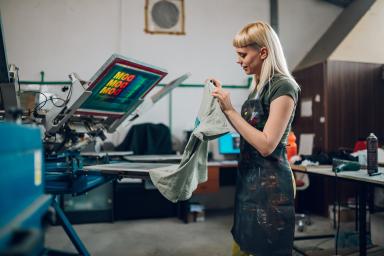How to start a clothing business
If you have an eye for style and have been considering the idea of becoming your own boss, why not combine the two and start your own clothing business?
Take advantage of your creative skills to launch a successful clothing line supplying fashion and clothes to a growing market.
The UK fashion industry is estimated to generate over £69 billion in revenue in 2025 and is expected to grow further in 2026.
With more people than ever buying clothes online and the ease of selling through personalised stores on well-known websites such as Not On The High Street and Etsy, setting up a clothing brand is an attractive proposition.
Starting a clothing business doesn’t have to be a scary prospect – you could start small.
For example, you might start by printing your own t-shirt designs at home or making one-off clothing creations in your spare time.
If the market demands it, you could consider expanding to a full-scale clothing line later.
With multiple approaches to consider, where do you start?
Read on to learn how to start a clothing business.
Step 1. Research the fashion market
The fashion industry is swamped with brands competing for customers so it’s vital to develop a unique brand that reflects your personality and fashion style.
Carrying out some market research could help you understand your potential customers, including:
- how they shop
- what they’re buying
- what prices they will pay.
You might also want to research competitors to understand what they’re doing well, what they’re missing, and how you can offer something different or better.
If you can spot a gap in the market, you could cater to people that the big fashion brands are ignoring.
For example, Alexandra McCabe set up FittaMama, selling a range of maternity fitness wear to health-conscious mums-to-be.
Market research helps you avoid costly mistakes by testing your ideas before you invest too much money or time.
It could also help you develop a strong brand identity and position your brand more effectively in the marketplace, increasing your chances of success.
Real-life example
Amy Barker and her partner, Michael, founded Monks & Co, an online fashion retailer and shop, after spending three months researching the market.
“I thought the business would work, but what the research came back with was always going to be the deciding factor,” says Amy.
“A staggering 89% of people asked would shop in the proposed store, and 40% of those even opted into marketing materials, so we already had a small database to start marketing to.”
For Monks & Co, the quality of service was a defining factor. “The internet is riddled with online shops, but trying to contact somebody from them isn’t easy”, says Amy.
“Our aim is to bring a personal touch to online shopping. That’s why at Monks Clothing there are real people behind the website, you can call us, tweet us, Facebook or email us and know you will get a reply from an actual person, not an automated service.”
Step 2. Choose a clothing line brand name
In the fashion world, having a strong brand name can be important because people often choose clothes based on the brand.
A good name and story could help your brand connect with customers.
For example, brands such as Quicksilver conjure up images of the surfing lifestyle, while Wrangler evokes images of cowboys and denim.
Some brands are named after their founders, like Burberry, Victoria Beckham, or Ted Baker.
If you want to invent a unique brand name, you might consider these ideas:
- brainstorm – gather inspiration from your brand’s mission, target customers and the style of clothing you plan to offer
- make it appealing – choose a name that creates the right feelings and images for your customers
- make it memorable – pick a name that is easy to say, spell, and remember
- avoid negative meanings – check that your name doesn’t have unintended negative associations, also considering different languages or cultures
- check if it's taken – search online to see if anyone else is already using the name to avoid legal issues
- check the website domain – check that you can get a website address with your brand name
- ask for feedback – share your shortlisted names with friends, family, or focus groups to see what they think
- test for longevity – choose a name that will still make sense and sound good as your brand grows.
To check that your clothing brand name isn’t already in use, you start by searching online for businesses in your market with similar names.
You could also check Company House’s register to see if a business with the same name already exists, and search the Intellectual Property Office to see if a name is registered as a UK trade mark.
Step 3. Decide how to sell your products
Choosing the most effective way to sell your clothes could be crucial to your business success.
There are a few main options for selling:
- physical shops – you could open your own store or set up short-term pop-up shops
- online – you could sell through your own website or use online marketplaces.
Regardless of the online sales platform you choose, you should be aware of UK online selling regulations regarding refunds, returns, and delivery terms.
Online marketplaces and e-commerce sites
Selling your clothing on sites such as Amazon, Etsy, eBay, and NotOnTheHighStreet may be an easy way to start.
These platforms usually charge you a monthly fee and take a percentage of your sales.
They let you reach millions of customers, build a following, and see how popular your products are.
Read our free guide on how to set up an eBay shop.
Your own website
When you’re ready and can keep up with demand, you might want to sell directly through your own website.
You’ll need to:
- choose a website hosting company
- set up a website with a shopping cart and secure payment options
- collect payments safely.
You could build a website yourself, buy a ready-made solution, or pay someone to design it for you.
Whatever route you take, make sure your website matches your brand style.
Good photos, clear descriptions, sizing information, and details about shipping and returns are all important elements for your clothing site.
Social media platforms
Social media platforms like Instagram, Facebook, and Pinterest could also offer unique opportunities to showcase your clothing line, connecting with customers, and getting feedback.
A bricks-and-mortar shop
If you like selling face-to-face, opening a bricks-and-mortar shop offers the opportunity to give customers a personal experience and build strong relationships.
A physical store could also boost your brand awareness – location is crucial to this, so consider areas with high foot traffic or locations that align with your target demographic.
Learn more about how to open a shop and start a retail business.
Pop-up stores
Pop-up shops let you sell in busy places like shopping centres, festivals, or markets without a long-term commitment.
They’re a good way to test new products, get feedback, and create buzz around your brand.
Retailers and distributors
You could sell to retailers and distributors if you don’t want to sell directly to consumers.
To do this, you will need to put together samples and information about how your products are made, how much you can produce, and the potential demand for them.
Distributors typically look for reliable suppliers who can scale to meet volume demand and offer discounting for bulk orders.
Step 4. Create a business plan
Creating a business plan could help get your clothing business off on the right foot and make it easier to raise funding.
It could include:
- brand statement and aims – explain what your fashion brand stands for, its mission and values, and how it is different
- target customers – identify your customers, including age, gender, and characteristics and explain why they would wear your clothing? How does it make them feel, and what does it say about them? What brands do they currently buy?
- clothing range – what clothing items will you offer? What is the range, what sizes do you offer, and in what colours? A good understanding of your audience will help here
- overhead costs – a list of all costs, including utilities, staffing and both fixed and variable expenses like materials
- supply chain and distribution – a plan for how your clothes will be produced, detailing the raw materials like textiles and packaging, sourcing methods, suppliers, and distribution arrangements
- marketing plan – a marketing strategy showing how you’ll promote your clothing line and an estimate of the expected ROI. If you’re selling through retailers, you could research business-to-business (B2B) marketing strategies to attract retail buyers
- financial forecasts – revenue projections and cost forecasts for the next three years could guide your business decisions and attract potential investors
- start-up funding – the total funding needed for your clothing business, including interest repayments on any loans or investments.
Create the perfect business plan with our free guide and template.
Step 5. Get funding for your clothing business
A small fashion business can often be started with little money, just what you put in yourself, and can grow slowly without needing to borrow.
If you’re making clothes yourself, you’ll need basic equipment, such as a sewing machine, thread, and fabric.
Many fashion brands start by selling t-shirts with their own designs.
You can make these at home with a screen printing kit, special ink, and blank t-shirts, which you can buy in bulk for a lower cost than if you were to source the shirts individually.
Alternatively, you could find a commercial screen printer to produce your designs.
Starting small means you might not need to pay suppliers, rent a workspace, or worry about storage and shipping costs at first.
But as your business grows – or if you want to expand quickly – you may need more money to cover expenses.
Raising finance for your clothing business may be tricky because it can be difficult to show exactly how much money you’ll make.
Traditional bank loans may be hard to come by, so you could consider funding alternatives available that could work instead.
These include small government grants, crowdfunding, angel investors and small business loans.
You might consider a government-backed Start Up Loan, which provides small business owners with up to £25,000 at a fixed 6% interest rate, as well as a year of free mentoring.
Step 6. Design and manufacture your clothes
When you’re just starting your clothing business, it could be a good idea to keep things simple by making only a few main items.
This helps keep your costs down until people start showing interest in your products.
You could focus initially on one type of product, such as slogan t-shirts or jackets.
You might decide to let demand be a determining factor – if these pieces sell, you could increase production and expand your line.
If you choose to look for an external manufacturer, take time to choose the best one for your business.
It can be tricky to figure out which manufacturer is best or how to clearly explain your ideas so they know exactly what you want.
Tech packs
One helpful tool is a technical – or ‘tech’ – pack containing the information they need to create your products.
A tech pack usually includes pictures of your item from different angles, details about sizes, colours, fabric types, and any logos or artwork.
Tech packs are important because your idea might be clear in your mind, but unless you explain it properly, the manufacturer might get it wrong.
A good tech pack could also mean that your first sample is as accurate as possible, saving you a lot of time.
Types of manufacturers
There are different ways to produce clothing depending on the direction you want to take your clothing business.
- Full Package Production (FPP) manufacturers handle everything from finding the fabric to making the final product, and they can help you take your idea from start to finish.
- CMT (Cut, Make, Trim) manufacturers make the clothes for you, but expect you to provide the fabric, patterns, and materials.
- Print on Demand (POD) Manufacturers print your designs on ready-made items. This is easy and low-risk, but you have less control over custom details.
You may find yourself working with a number of manufacturers before you find the one who can provide the quality and scale you need.
London-based clothing producer Hawthorn explains the pros and cons of these three manufacturing types in their own comprehensive guide to starting a clothing line.
Step 7. Register your clothing business
Starting a clothing business can be exciting, but it’s important not to ignore the paperwork and business side to ensure things run legally.
You’ll still need to keep track of cash flow, pay suppliers, deal with expenses and taxes, manage staff if you hire any, and aim to make a profit.
You must register as a self-employed sole trader with HMRC – unless you choose to set up a limited company or partnership – so you can pay the correct amount of income tax and national insurance.
Even if you only design and sell clothes part-time, you still need to register.
You may want to keep records of all your business transactions and expenses in one easy-to-find place, which could make filling in your self-assessment form much easier.
Alternatively, you could hire an accountant to manage your business finances.
Although this costs money upfront, it could help reduce your tax bills in the long run – read our guide on how to find a good accountant.
Learn more with our small business bookkeeping tips for success.
Step 8. Promote your clothing brand
Promoting and marketing your small business could be key to its success.
How you market and advertise will often depend on how much money you can spend.
Learn more about marketing on a shoestring.
If you’re working with a small budget, there are plenty of low-cost ways to promote your brand.
If you have more money to spend, you could hire a fashion PR (public relations) expert to help get your brand noticed.
You might want to pay them based on the results they deliver.
Other marketing tips include:
- be a walking billboard – wearing your own clothes and getting friends and family to do so too is free advertising
- use social media – platforms such as Instagram, Facebook, TikTok, and Pinterest could be ideal for showcasing your products with engaging visuals and stories. Use social media to talk to customers and create a buzz around your brand. Read our guide on using social media to market your business
- work with fashion influencers – influencers have followers who trust their recommendations. You might choose to partner with influencers who share your brand’s values and aesthetics. Don’t simply rely on sending them free samples – get to know them and what excites them. Find creative ways to work together, such as competitions, giveaways, sponsored posts, and ads
- showcase your clothing at a fashion show – hiring even a small booth at a trade show may be expensive but the opportunity to promote your brand and network with fashion buyers, fashion writers, and others designers could be priceless
- use professional photography – if you sell online, your social media and websites are essentially your shop window. High-quality photos help your clothes look their best and make your brand look professional. Hiring a good fashion photographer can help you stand out.
You may want to use a variety of marketing tactics to increase your clothing business’s reach and encourage sales.
Read our essential guide to marketing for more guidance on how to promote your business.
Case study: H.E.R Bodywear
Interested in learning how applying for a Start Up Loan could help get your clothing business off the ground?
Alexandra Perry took out a £14,500 Start Up Loan with support from our business support partner First Enterprise to start her clothing line, H.E.R Bodywear, in Nottingham.
She used the funding to set up the production process for her specially designed bras and market the business.
Learn more about H.E.R Bodywear's Start Up Loan journey.
Learn with Start Up Loans and help get your business off the ground
Thinking of starting a business? Check out our free online courses in partnership with the Open University on being an entrepreneur.
Our free Learn with Start Up Loans courses include:
- Entrepreneurship – from ideas to reality
- First steps in innovation and entrepreneurship
- Entrepreneurial impressions – reflection
Plus free courses on climate and sustainability, teamwork, entrepreneurship, mental health and wellbeing.
Disclaimer: The Start -Up Loans Company makes reasonable efforts to keep the content of this article up to date, but we do not guarantee or warrant (implied or otherwise) that it is current, accurate or complete. This article is intended for general information purposes only and does not constitute advice of any kind, including legal, financial, tax or other professional advice. You should always seek professional or specialist advice or support before doing anything on the basis of the content of this article.
The Start-Up Loans Company is not liable for any loss or damage (foreseeable or not) that may come from relying on this article, whether as a result of our negligence, breach of contract or otherwise. “Loss” includes (but is not limited to) any direct, indirect or consequential loss, loss of income, revenue, benefits, profits, opportunity, anticipated savings, or data. We do not exclude liability for any liability which cannot be excluded or limited under English law. Reference to any person, organisation, business, or event does not constitute an endorsement or recommendation from The Start-Up Loans Company, its parent company British Business Bank plc, or the UK Government.



